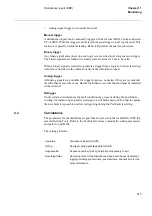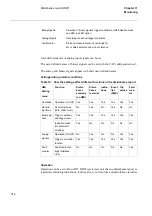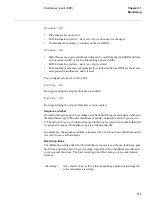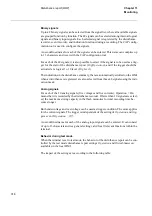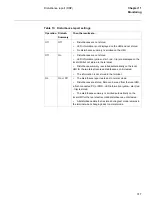
326
Event recorder
&KDSWHU
0RQLWRULQJ
(YHQWUHFRUGHU
$SSOLFDWLRQ
When using a front-connected PC or Station Monitoring System (SMS), an event list
can be available for each of the recorded disturbances in the disturbance report. Each
list can contain up to 150 time-tagged events. These events are logged during the total
recording time, which depends on the set recording times (pre-fault, post-fault and limit
time) and the actual fault time. During this time, the first 150 events for all the 48 se-
lected binary signals are logged and time tagged. This list is a useful instrument for
evaluating a fault and is a complement to the disturbance recorder.
To obtain this event list, the event recorder function (basic in some terminals and op-
tional in others) must be installed.
)XQFWLRQDOLW\
When one of the trig conditions for the disturbance report is activated, the events are
collected by the main processing unit, from the 48 selected binary signals. The events
can come from both internal logical signals and binary input channels. The internal sig-
nals are time tagged in the main processing module, while the binary input channels are
time tagged directly on each I/O module. The events are collected during the total re-
cording time,
W5HFRUGLQJ
, and they are stored in the disturbance report memory at the
end of each recording.
The name of the binary input signal that appears in the event list is the user-defined
name that can be programmed in the terminal.
The time tagging of events emerging from internal logical signals and binary input
channels has a resolution of 1 ms.
&DOFXODWLRQV
The parameters for the event recorder function are set via the local HMI or PST (Param-
eter Setting Tool). Refer to the Technical reference manual for setting parameters and
path in local HMI.
The settings of the event recorder consist of the signal selection and the recording times.
It is possible to select up to 48 binary signals, either internal signals or signals coming
from binary input channels. These signals coincide with the binary signals recorded by
the disturbance recorder. The disturbance summary indications that are to scroll auto-
matically on the local human-machine interface (HMI), can only be selected from these
48 event channels.
Summary of Contents for REO 517
Page 10: ... RQWHQWV ...
Page 16: ...6 Introduction to the application manual KDSWHU QWURGXFWLRQ ...
Page 64: ...54 Blocking of signals during test KDSWHU RPPRQ IXQFWLRQV ...
Page 88: ...78 Scheme communication logic ZCOM KDSWHU LQH LPSHGDQFH ...
Page 146: ...136 Unbalance protection for capacitor banks TOCC KDSWHU XUUHQW ...
Page 166: ...156 Dead line detection DLD KDSWHU 3RZHU V VWHP VXSHUYLVLRQ ...
Page 378: ...368 Monitoring of DC analog measurements KDSWHU 0RQLWRULQJ ...
Page 384: ...374 Pulse counter logic PC KDSWHU 0HWHULQJ ...
Page 412: ...402 Serial communication modules SCM KDSWHU DWD FRPPXQLFDWLRQ ...
Page 440: ...430 LED indication module KDSWHU DUGZDUH PRGXOHV ...


